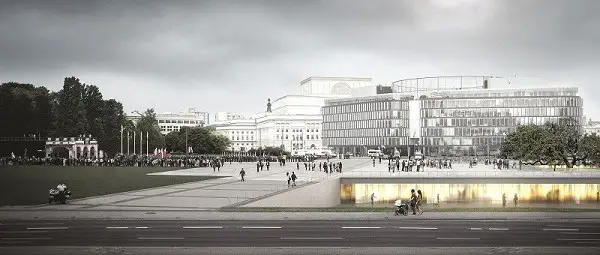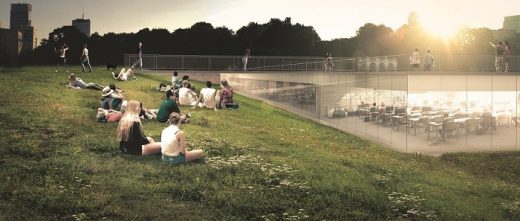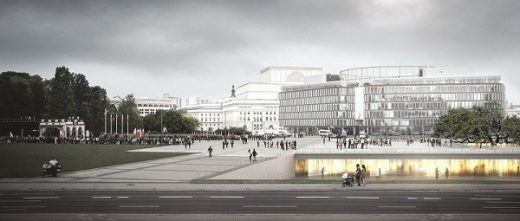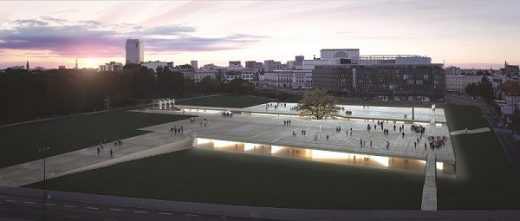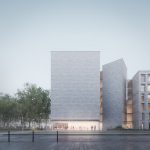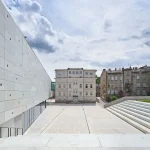Institute for Disarmament of Culture and Abolition of War, Warsaw Conceptual Building, Architecture Images
Institute for Disarmament of Culture and Abolition of War in Warsaw
Conceptual Building in Poland design by Krzysztof Wodiczko and Jarosław Kozakiewicz
15 Nov 2016
Design: Krzysztof Wodiczko and Jarosław Kozakiewicz
Location: Piłsudski Square, Warsaw, Poland
Institute for Disarmament of Culture and Abolition of War
Institute for Disarmament of Culture and Abolition of War
‘Disarming culture’ is a conceptual project for an unusual architectural object – The Institute for Disarmament of Culture and Abolition of War – under the surface of Piłsudski Square in Poland’s capital, Warsaw. The project is the starting point for discussions about peace, art and history, and for a debate on the establishment of the Institute itself.
The design was first shown at one of the country’s most important art galleries, Warsaw’s Zachęta — National Gallery of Art, in October 2016.
The conceptual project for the Institute for Disarmament of Culture and Abolition of War in the historic centre of Warsaw was envisaged by world-renowned visual artist Krzysztof Wodiczko and the outstanding creator of various architectural projects, sculptor Jarosław Kozakiewicz. The designers have placed all of the Institute’s functional areas and infrastructure under the surface of Piłsudski Square, which is one of the most important historical places in Poland, and the traditional site of the nation’s military parades.
According to the project, the structure will be sunk under the ground without disturbing the historical foundations of the Saxon Palace – a defunct building from the turn of the 17th century, destroyed during World War II. The Institute will also be visible and accessible from the level of the square.
A special hydraulic system can be used to block the passage to the Tomb of the Unknown Soldier. Erected to commemorate nameless soldiers, the grave-cum-monument was created in the colonnade of the Saxon Palace in 1925 and remains as its only existing part.
In Wodiczko and Kozakiewicz’s design, it forms the spatial axis of the Institute for Disarmament of Culture and Abolition of War. The link between the Institute and Poland’s most important memorial will be a symbolic manifestation and evidence of the Institute’s peace-making mission.
It was the designers’ intention to emphasize the role of the Institute’s location, particularly in the context of the turbulent history of Poland and Europe. Poland – a country that had already been tried severely in World War I – lost nearly 6 million of its citizens during World War II. This is why the designers’ vision was to make the Institute’s mission one of developing the concept of culture of peace and refraining from violence in resolving disputes.
Krzysztof Wodiczko and Jarosław Kozakiewicz’s project envisages some development of the area around Piłsudski Square, and making it an open space for recreation and the education of the residents of Warsaw and the tourists visiting the capital. It features a special observation deck rising above the Tomb of the Unknown Soldier, which will be available both from the level of the square, as well as from the special Passage, and will enable visitors to truly appreciate the scale of the building and the remarkable form of the Institute.
A Tree will be the central point of the Passage, right next to the main entrance to the Institute, covered in glass and open to the city and its residents. The building’s right wing has been designated for a permanent exhibition that tells the story of conflicts, war and peace-making.
At its centre there will be a reconstructed meeting hall with a replica of the famous Round Table, which, in 1989, seated the negotiations between the communist authorities and the Solidarity trade union that led to the fall of the first communist regime in Eastern Europe.
In the Hall of the Makers of Peace, visitors will learn about the achievements of Nobel Prize winners and other winners of peace prizes, people who greatly influenced the development of anti-war movements and worked for peaceful conflict resolution. Apart from the patron of the Institute, Joseph Rotblat, it will present the profiles of the Workers’ Defence Committee members (a Polish anti-communist organization operating in the 1970s), Shimon Peres, Bertrand Russell, Pablo Picasso and Albert Einstein, and the leaders of the Women’s League of Peace.
The multimedia exhibition zone will be a place to show curated projects in the field of culture, art and education, related to issues in building peace. It will also be a space to present the works of major artists who created on the subject of war and peace, for example, Francisco Goya, Martha Rosler, the Polish painters Artur Grottger and Andrzej Wróblewski, as well as Yoko Ono and John Lennon.
The exhibition area is located next to an auditorium that will be a venue for conferences, congresses, and multimedia shows. This open space will also serve as a meeting and public discussion place. The wing has also been arranged to hold temporary and individual exhibitions, as well as educational facilities.
The most important area in the left wing of the Institute for Disarmament of Culture and Abolition of War will be the Situational Room, with its interactive multimedia map of the world monitoring and visualizing armed conflicts – those taking place right now and those settled by negotiation and mediation. This section of the Institute will also include film projection rooms, a library with an archive, a space dedicated to multimedia installations, exhibitions, performances and workshops, as well as rooms for group and individual academic research.
In their project, Krzysztof Wodiczko and Jarosław Kozakiewicz want to create a friendly space for discussion, education and talking about the ways that memory, history and art can help build a future free of war. In this way, disarming culture becomes an interdisciplinary project.
It is at the same time an idea and a specially designed space, where knowledge of the past meets with thinking about the future. Its creators want researchers and practitioners in the fields of culture, education, philosophy and law to take action to prevent and eliminate armed conflicts.
The concept of the Institute for Disarmament of Culture and Abolition of War is grounded in the belief that “War must cease to be an admissible social institution. We must learn to resolve our disputes by means other than military confrontation.”
This sentence, uttered by Joseph Rotblat in 1995, when he received the Nobel Peace Prize, is intended to be the starting point for analyses and discussions on the involvement of art in the glorification of war and the perception of history in terms of struggles, victories, and defeats.
Joseph Rotblat, who will be the patron of the Institute, was an outstanding Polish physicist and radiobiologist. During World War II, he worked on the Manhattan Project, helping build the first atomic bomb, and then became one of the biggest critics of weapons of mass destruction.
Krzysztof Wodiczko – visual artist and art theorist. He is mainly the creator of various social actions, videos, and theoretical works. He has often worked with the themes of war and peace, including a ‘Hiroshima’ project presented in 1999 to the Atomic Bomb Dome in Hiroshima.
In 1998, he received The Hiroshima Art Prize, which is awarded to artists “who, acting in the field of contemporary art, contributed significantly to the peaceful coexistence of humankind.” He lives in the United States.
Jarosław Kozakiewicz – sculptor, visual artist and designer of architectural concepts. The creator of many innovative designs. In 2006, he represented Poland at the 10th Biennale of Architecture in Venice. His works include the famed ‘Project Mars’, which is part of the revitalization of the landscape park around Lake Bärwalder in Germany, and the ‘Bridge of Ghosts’ in Auschwitz.
Institute for Disarmament of Culture and Abolition of War images / information received 151116
Location: Piłsudski Square, Warsaw, Poland, eastern Europe
New Polish Architecture
Contemporary Polish Architecture
Polish Architectural Designs – chronological list
Warsaw Architecture Tours by e-architect
Konieczny’s Ark, Brenna, Poland
Architects: KWK PROMES
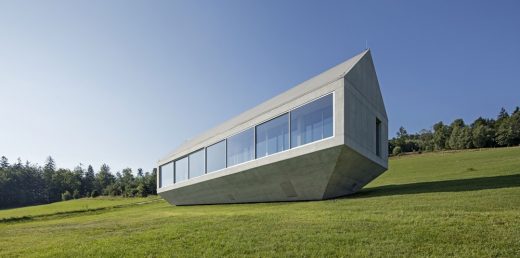
photo : Olo Studio
Contemporary Polish Building
Q22 Office Building, Warsaw
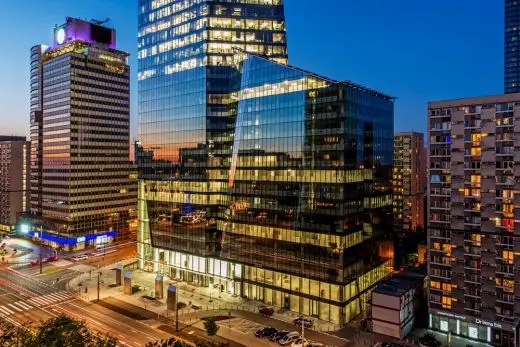
photography : Echo Investments
Q22 Office Building Warsaw
Poland National Stadium Building in Warsaw
Comments / photos for the Institute for Disarmament of Culture and Abolition of War in Warsaw design by Krzysztof Wodiczko and Jarosław Kozakiewicz page welcome

